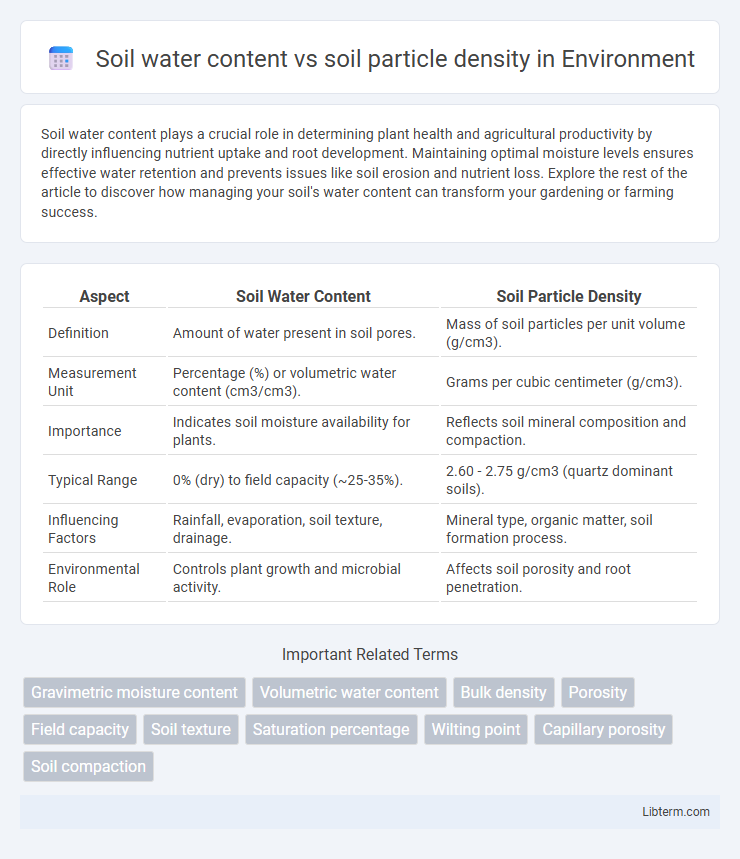Soil water content plays a crucial role in determining plant health and agricultural productivity by directly influencing nutrient uptake and root development. Maintaining optimal moisture levels ensures effective water retention and prevents issues like soil erosion and nutrient loss. Explore the rest of the article to discover how managing your soil's water content can transform your gardening or farming success.
Table of Comparison
| Aspect | Soil Water Content | Soil Particle Density |
|---|---|---|
| Definition | Amount of water present in soil pores. | Mass of soil particles per unit volume (g/cm3). |
| Measurement Unit | Percentage (%) or volumetric water content (cm3/cm3). | Grams per cubic centimeter (g/cm3). |
| Importance | Indicates soil moisture availability for plants. | Reflects soil mineral composition and compaction. |
| Typical Range | 0% (dry) to field capacity (~25-35%). | 2.60 - 2.75 g/cm3 (quartz dominant soils). |
| Influencing Factors | Rainfall, evaporation, soil texture, drainage. | Mineral type, organic matter, soil formation process. |
| Environmental Role | Controls plant growth and microbial activity. | Affects soil porosity and root penetration. |
Introduction to Soil Water Content and Soil Particle Density
Soil water content refers to the amount of water contained in the soil pores, measured as a percentage of the soil's volume or weight, and critically influences plant growth and microbial activity. Soil particle density is the mass of soil particles per unit volume, typically ranging from 2.60 to 2.75 g/cm3, affecting soil porosity and water retention capacity. Understanding the relationship between soil water content and particle density helps optimize irrigation practices and manage soil health for sustainable agriculture.
Defining Soil Water Content
Soil water content, defined as the volume or mass of water contained in the soil, directly influences soil particle density, which is the mass of soil solids per unit volume excluding pore spaces. Measuring volumetric water content provides critical insights into the saturation level of soil pores, affecting nutrient availability and soil structure stability. Understanding the relationship between soil water content and particle density helps optimize irrigation management and predicts soil behavior under varying moisture conditions.
Understanding Soil Particle Density
Soil particle density typically ranges from 2.60 to 2.75 g/cm3, reflecting the mass of solid soil particles per unit volume and influencing pore space and water retention capacity. Higher soil particle density often correlates with lower soil water content due to reduced porosity and limited space for water storage. Understanding soil particle density is essential for predicting soil behavior, irrigation needs, and managing water availability for plant growth.
Importance of Measuring Soil Water Content
Measuring soil water content is crucial for understanding soil particle density because it directly influences soil porosity and bulk density assessments. Accurate soil water content data helps optimize irrigation scheduling, enhancing water use efficiency and crop yield. It also aids in determining soil health and managing erosion risks by reflecting moisture retention capacity relative to particle density.
Role of Soil Particle Density in Soil Structure
Soil particle density plays a critical role in defining soil structure by influencing soil porosity, which directly affects soil water content and retention capacity. Higher soil particle density typically reduces pore space, limiting water infiltration and availability to plants. Effective management of soil particle density through amendments enhances soil aggregation, improving water holding capacity and overall soil health.
Relationship Between Soil Water Content and Particle Density
Soil water content is inversely related to soil particle density, as soils with higher particle density typically have lower pore spaces available for water retention. Fine-textured soils with smaller particle sizes, such as clay, exhibit higher water content due to their increased surface area and porosity compared to coarse-textured soils like sand with lower particle density. Understanding this relationship aids in optimizing irrigation practices and managing soil health in agriculture and environmental science.
Factors Influencing Soil Water Content and Particle Density
Soil water content is primarily influenced by soil texture, organic matter, and pore size distribution, which govern water retention and movement. Soil particle density depends on mineral composition and particle size, affecting soil structure and porosity. Both parameters are interrelated; fine-textured soils with higher clay content tend to have greater water retention but also higher particle density due to compact mineral particles.
Methods for Determining Soil Water Content
Soil water content is commonly determined using gravimetric methods, which involve weighing soil samples before and after oven drying to calculate moisture loss, providing accurate data on water content relative to particle density. Time-domain reflectometry (TDR) probes measure dielectric constants correlating with volumetric water content across varying soil particle densities, facilitating non-destructive in situ monitoring. Neutron scattering techniques offer precise water content measurements independent of soil texture by analyzing hydrogen atoms in soil pores, making them effective for soils with diverse particle densities.
Techniques for Measuring Soil Particle Density
Techniques for measuring soil particle density include the pycnometer method, gas pycnometry, and helium displacement, which provide precise volume measurements of soil solids. The pycnometer method uses water displacement to calculate density, while gas pycnometry and helium displacement offer non-destructive alternatives for fine particles by measuring gas volume changes. Accurate determination of soil particle density informs soil water content assessments by distinguishing between pore space and solid particles in the soil matrix.
Implications for Agriculture and Environmental Management
Soil water content directly influences crop productivity by affecting root water availability, while soil particle density determines soil porosity and water retention capacity, critical for irrigation efficiency and drainage management. Variations in soil particle density impact soil aeration and hydraulic conductivity, thereby influencing nutrient uptake and plant health. Understanding the relationship between soil water content and particle density aids in optimizing water usage, improving soil structure, and mitigating erosion risks in agricultural and environmental management practices.
Soil water content Infographic

 libterm.com
libterm.com